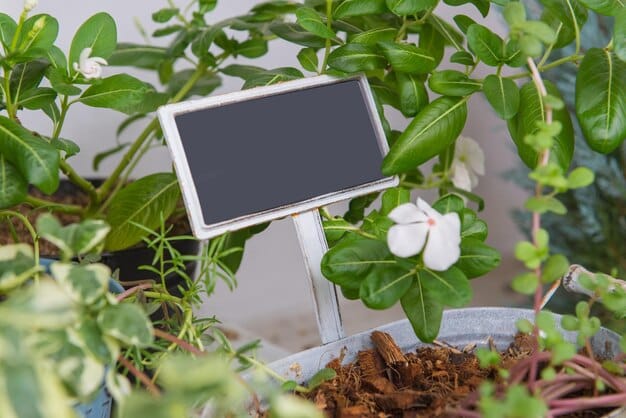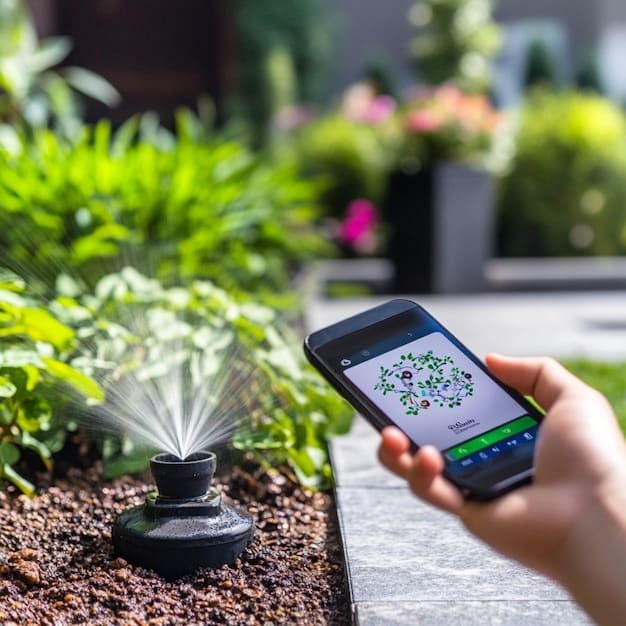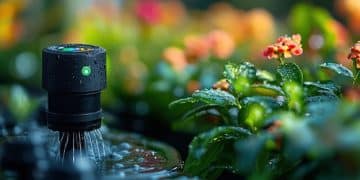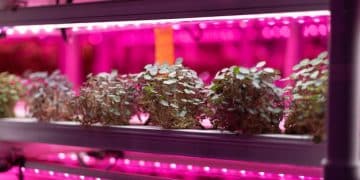Smart Irrigation Systems: Save Water & Optimize Lawn Care

Smart irrigation systems offer a revolutionary approach to lawn care by automating watering schedules, conserving water, and ensuring optimal hydration for a healthy and vibrant landscape.
Imagine a perfectly green lawn, thriving plants, and a significantly lower water bill – all thanks to a smart irrigation system. These innovative systems are transforming how we care for our landscapes, offering automated schedules and efficient water usage. Let’s dive into how smart irrigation systems: saving water and optimizing lawn care with automated schedules can benefit you.
Understanding Smart Irrigation Systems
Smart irrigation systems are advanced watering solutions that use sensors, weather data, and user-defined parameters to optimize water usage. Unlike traditional sprinkler systems that operate on a fixed schedule, smart systems adapt to real-time conditions, ensuring your lawn and garden receive exactly the right amount of water, no more, no less.
Key components of a smart irrigation system:
Understanding the components that make up a smart irrigation system is vital to comprehending efficiency and effectiveness. These components work together seamlessly to deliver a state-of-the-art watering solution.
- Smart Controllers: The brains of the system, allowing you to program and manage watering schedules remotely via a smartphone or computer.
- Weather Sensors: These detect rainfall, temperature, humidity, and other weather conditions to adjust watering schedules automatically.
- Soil Moisture Sensors: Placed in the ground, these sensors measure the moisture level in the soil and trigger watering only when needed.
- Smart Sprinklers and Drip Irrigation: These deliver water precisely where it’s needed, minimizing waste and maximizing efficiency.
By integrating these components, smart irrigation systems create a dynamic and responsive watering approach that saves water and promotes plant health.
In essence, these systems move beyond guesswork, offering a precise and efficient approach to lawn care, tailored to environmental conditions.
The Benefits of Automated Schedules
One of the primary advantages of smart irrigation systems is their ability to automate watering schedules. This feature not only saves time but also ensures that your lawn receives consistent and optimal hydration.
Customizable Watering Schedules:
Smart systems allow you to set specific watering schedules based on plant type, soil conditions, and local weather patterns. This customization ensures that each area of your lawn receives the precise amount of water it needs.
- Zone-Based Watering: Divide your yard into zones (e.g., lawn, garden, flowerbeds) and create separate watering schedules for each.
- Time-Based Restrictions: Adhere to local watering restrictions by setting specific days and times for irrigation.
- Seasonal Adjustments: Easily adjust watering schedules as the seasons change and plant water requirements evolve.
Having flexible watering schedules is fundamental in adapting to seasonal variations and specific plant needs, which optimizes water usage.
With automated schedules, you can relax knowing that your lawn is receiving the right amount of water at the right time, without the need for manual intervention.

Saving Water with Smart Technology
Water conservation is a critical concern, and smart irrigation systems offer a practical solution for reducing water waste. By using advanced technology to monitor and adjust watering schedules, these systems minimize water consumption while maintaining a healthy landscape.
Traditional sprinkler systems often overwater lawns, leading to significant water waste. Smart systems, on the other hand, use weather data and soil moisture sensors to deliver water only when and where it’s needed. For example, if it rains, the system will automatically postpone watering, preventing unnecessary irrigation.
The statistics speak for themselves. Studies have shown that homeowners who switch to smart irrigation systems can reduce their water usage by as much as 30-50%. This not only lowers water bills but also helps conserve precious resources.
Real-World Water Conservation:
Using smart features contributes directly to preserving water in our environment.
- Rain Delay: Systematically postpones scheduled watering to prevent overwatering during rainy days.
- Evapotranspiration (ET) Adjustment: Measures the quantity of water evaporating from the soil and plant transpiration, altering schedules for maximal effectiveness.
- Leak Detection: Some advanced systems are capable of identifying leaks within the system, informing users to address issues before significant water loss occurs.
These examples highlight how smart irrigation systems integrate environmentally conscious practices into lawn care management.
With water costs on the rise and increasing environmental awareness, investing in a smart irrigation system is a responsible and sustainable choice.
Optimizing Lawn Care for Healthy Growth
Beyond water conservation, smart irrigation systems play a vital role in optimizing lawn care for healthy growth. By delivering the right amount of water at the right time, these systems promote strong root development and vibrant foliage.
Overwatering can lead to various problems, including fungal diseases, shallow root systems, and nutrient runoff. Smart irrigation systems prevent these issues by ensuring that the lawn receives consistent and appropriate hydration. Soil moisture sensors, in particular, help maintain optimal moisture levels, promoting healthy root growth and overall plant health.
A lawn that’s properly watered is better able to withstand stress from heat, drought, and pests. Smart irrigation systems also contribute to the longevity and beauty of your landscape.
Enhancing soil and plant health:
Smart irrigation facilitates better soil and plant environments through:
- Reduced Disease Risk: Minimizes the incidence of fungal infections and root rot through controlled watering.
- Nutrient Management: Limits nutrient runoff by optimizing soil hydration, sustaining a healthy nutrient ecosystem within the soil.
- Stronger Roots: Encourages deep root development, improving plant resilience and water absorption capacities.
Through these enhancements, smart irrigation systems become an integral part of maintaining a vibrant and sustainable backyard.
Investing in a smart irrigation system is an investment in the long-term health and beauty of your lawn. These systems guarantee your land stays luxuriant and withstands the seasons.

Choosing the Right Smart Irrigation System
Selecting the right smart irrigation system requires careful consideration of your specific needs and preferences. With numerous options available on the market, it’s essential to evaluate various factors, including system features, compatibility, and cost.
Begin by assessing the size and layout of your lawn. Consider the different zones you want to irrigate and the specific water requirements of your plants. Next, research different smart controllers and sensors, paying attention to their ease of use, reliability, and integration capabilities. Read customer reviews and compare ratings to gain insights into the performance of each system.
Also, consider the cost of installation and maintenance. While smart irrigation systems may have a higher upfront cost than traditional systems, their long-term water savings and enhanced lawn health make them a worthwhile investment.
Key considerations include:
Careful system choice enhances efficiency and performance, maximizing positive effects for your landscape.
- Compatibility with Existing Systems: Make certain the new components can integrate with your existing infrastructure to avoid a complete overhaul.
- Ease of Use: Opt for systems with user-friendly interfaces, making setup and adjustments hassle-free.
- Scalability: Choose systems that allow expansion if you intend to add more zones or features in the near future.
These factors ensure your choice leads to a lasting improvement of landscape management practices.
By carefully evaluating your options, you can choose a smart irrigation system that meets your needs, saves water, and promotes a healthy, thriving lawn.
Installation and Maintenance Tips
Proper installation and maintenance are essential for ensuring the long-term performance of your smart irrigation system. While some homeowners may choose to hire a professional installer, DIY enthusiasts can successfully install these systems with the right guidance and tools.
Start by carefully planning the layout of your irrigation system, taking into consideration the placement of sprinklers, sensors, and controllers. Follow the manufacturer’s instructions closely during installation, and double-check all connections to prevent leaks.
Regular maintenance is also crucial. Inspect sprinklers and drip lines for clogs or damage, and clean or replace them as needed. Monitor soil moisture sensors and weather data to ensure accurate readings. Periodically check the controller settings and adjust watering schedules as necessary to optimize water usage.
Optimizing system lifecycle:
Implementing these tips ensures your system functions optimally and endures over time.
- Winterization: Prepare your system for cold temperatures by completely draining water-filled components to prevent freezing and damage.
- Software Updates: Stay updated with the latest software versions for your controller to access improvements and new features.
- Professional Check-ups: Schedule yearly check-ups with professionals to detect and rectify minor issues before they escalate.
Staying consistent with these suggestions extends the functional timeline of smart systems.
With proper installation and maintenance, your smart irrigation system will provide years of efficient watering, helping you conserve water and maintain a beautiful, healthy lawn.
| Key Point | Brief Description |
|---|---|
| 💧 Water Conservation | Smart systems reduce water waste by up to 50% using sensors and weather data. |
| 📅 Automated Schedules | Customizable schedules adapt to plant needs and weather changes, saving time. |
| 🌱 Healthy Lawn Growth | Optimal watering promotes strong roots and vibrant foliage, reducing disease risk. |
| 📱 Remote Management | Control and monitor your system from anywhere via smartphone app. |
Frequently Asked Questions (FAQ)
Smart irrigation systems use sensors and weather data to adjust watering schedules, delivering water only when needed and preventing overwatering. This targeted approach minimizes water waste.
Yes, most smart irrigation systems come with a smartphone app that allows you to monitor and control your system from anywhere. You can adjust schedules, check sensor readings, and receive alerts.
With the right tools and guidance, many homeowners can install a smart irrigation system themselves. Professional installation is also an option if you prefer not to do it yourself.
Soil moisture sensors are placed in the ground and measure the amount of moisture in the soil. They send this data to the smart controller, which adjusts watering schedules accordingly to maintain optimal moisture levels.
Regular maintenance includes inspecting sprinklers and drip lines for clogs or damage, cleaning or replacing them as needed, and monitoring sensor readings to ensure accuracy.
Conclusion
Smart irrigation systems represent a leap forward in lawn care, offering automated schedules that save water, optimize plant health, and provide convenience. By understanding the components, benefits, and best practices of these advanced systems, homeowners can make informed decisions and enjoy a beautiful, sustainable landscape.





